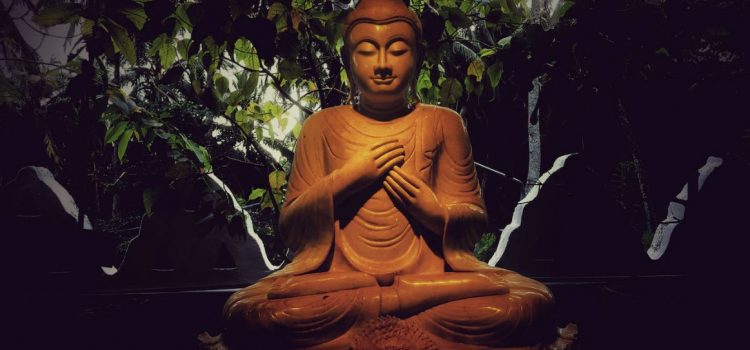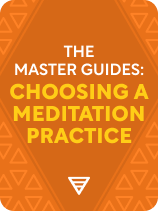

This article is an excerpt from the Shortform book guide to "The Master Guides: Choosing a Meditation Practice" by Shortform. Shortform has the world's best summaries and analyses of books you should be reading.
Like this article? Sign up for a free trial here.
What is Buddhist meditation? What are the two most popular types? What is the Noble Eightfold Path of Buddhism?
Buddhism is a religion often associated with meditation and mindfulness. Buddhism focuses on finding happiness through self-improvement, rather than through understanding God or seeking divine guidance.
Here’s a look at the background of Buddhist meditation, including vipassana and metta meditation.
Buddhist Meditation
What is Buddhist meditation? Buddhism is helpful for learning acceptance—the ability to recognize and acknowledge problems without becoming overwhelmed by them. Buddhist meditations are particularly helpful for managing strong emotions such as anxiety, anger, and grief.
Background: Buddhist Beliefs
The core tenet of Buddhism is following a balanced lifestyle of neither rejecting pleasures nor chasing them: “the middle way,” as Siddhartha Gautama, better known as the Buddha, phrased it. In this way, he and his followers were able to fully enjoy the good things in their lives, yet remain calm and patient when those pleasures were absent.
The Buddha taught that people are unhappy because they chase after pleasure, but those pleasures are temporary. That leaves people dissatisfied and always wanting more. However, the Buddha also offered hope in the form of the Noble Eightfold Path, which he promised would eliminate those frustrating desires and bring inner peace.
The Noble Eightfold Path of Buddhism consists of the following eight practices—note that meditation is a crucial part of the path:
- Correct understanding—seeing the world as it truly is, instead of as you want it to be
- Correct thought—rejecting thoughts of desire and animosity
- Correct speech—avoiding lies and hurtful words
- Correct action—ethical behavior
- Correct livelihood—avoiding occupations that cause harm directly (like fighting in wars) or indirectly (like selling alcohol or other drugs)
- Correct effort—working tirelessly toward enlightenment
- Correct mindfulness—awareness of yourself, your mental and physical state, and your surroundings
- Correct concentration—single-minded focus; meditation
Taken together, these eight practices establish a lifestyle that Buddhists believe will release them from desire and suffering, allowing them to live happy, fulfilling lives.
Styles of Buddhist Meditation
Two popular types of Buddhist meditation are vipassana and metta.
Vipassana: Mindfulness
The Buddhist monk Bhante Henepola Gunaratana describes vipassana meditation in his book Mindfulness in Plain English. Vipassana will help you to recognize that your impulses—your desires and aversions—have no power over you. With that understanding, you’ll be able to take thoughtful, mindful actions, instead of simply reacting to your moment-to-moment impulses.
In vipassana meditation, you examine the processes of perception and thought, and learn to separate them. In other words, you acknowledge what you see, hear, smell, feel, or experience in any way—but you do so without judgments or reactions.
For example, if you smell a skunk, you would simply acknowledge that it’s the smell of a skunk; you wouldn’t judge it as unpleasant, try to ignore it, or close a window to shut it out. The same goes for any emotions that arise during your meditation: Recognize and acknowledge them, but don’t judge them as positive or negative, and don’t try to embrace them or push them away. Simply allow your experiences to arise and pass naturally, in their own time.
Gunaratana recommends using your own breath as a focus for your meditation. Note each step of each breath: inhaling, holding the breath in your lungs, and exhaling. Notice how quickly and how deeply you’re breathing, but don’t try to change how you breathe during your meditation—just observe.
From this central focus of breathing, note all other physical and mental phenomena that arise—in other words, any distractions—again without judging them or trying to control them.
At times, you’ll find yourself incapable of wrangling your mind from thinking random thoughts. You’ll not be aware of where the thoughts come from, and you’ll feel crazy. Realize that your mind has always been this way—you’ve just never noticed before. Gently but firmly return to your focus. Don’t get upset or judge yourself for straying. Don’t try to force things out of your mind; doing so only adds energy to the thoughts, and it’ll make them return stronger.
When you’re first starting out with vipassana, set small goals. For instance, try to focus for just one inhalation and exhalation. You’ll still fail at times, but keep at it.
Through vipassana, you’ll learn a great deal about yourself. For example, you’ll discover why you experience emotions like greed, hatred, and anger, and you’ll learn not to let those feelings control you. You’ll learn how to accept things that you dislike, such as the idea of growing old or having your mistakes pointed out.
Metta: Lovingkindness
Another type of Buddhist meditation is metta, translated as “lovingkindness.” Psychologist Tara Brach discusses this practice in Radical Acceptance, where she describes metta as a wish for others’ health and happiness.
Practicing metta involves mentally sending love to people you like, people you don’t like, and people who’ve helped you. This kind of meditation allows you to practice compassion toward everyone—even those who’ve hurt you. By doing so, you’ll discover that you’re capable of deep feelings of compassion; eventually, after practicing metta for long enough, you’ll have intense feelings of vicarious joy and sympathy even for people you’ve never met. Wishing for universal peace and happiness helps you to reconnect with the essential goodness that exists in all people.
Traditionally, when practicing metta, you begin with yourself: Reflect on your own innate goodness, and offer yourself wishes for peace, joy, and feelings of metta.
After that, expand your circle of lovingkindness to include the people closest to you. It’s often easiest to begin with a single person: the one whose goodness is easiest for you to see. This could be a child, a parent, a grandparent, or a friend—there’s no “correct” person to choose. Once you have someone in mind, meditate on what you love about that person and offer them the same wish for happiness that you offered yourself.
Once that’s done, widen your circle of metta to include other people whom you’re close to, then people you don’t know as well, and, eventually, people whom you don’t know at all.The most challenging part of this exercise is to experience lovingkindness for those who stir feelings of dislike or anger in you. Offering those people wishes of peace and happiness is likely to feel forced and hollow at first. However, if you acknowledge those negative feelings and let them pass (as in vipassana meditation), you can continue offering your well-wishes. In doing so, you’ll find that those wishes start feeling more sincere—in other words, by offering love to others even when you don’t mean it, you’ll start to awaken genuine caring feelings within yourself.

———End of Preview———
Like what you just read? Read the rest of the world's best book summary and analysis of Shortform's "The Master Guides: Choosing a Meditation Practice" at Shortform.
Here's what you'll find in our full The Master Guides: Choosing a Meditation Practice summary:
- The best, time-tested advice on meditation from meditation experts
- A look at each of the four major meditation traditions
- How to choose a meditation practice that's right for you and your lifestyle






